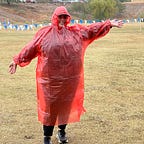Agility Course Design Tricks: Perfect Nesting
Leaving equipment right where it is, for fun and profit!
When an agility course is “nested” with another, it means some or all of the major equipment on the field stays in the same place between two different rounds of competition.
Advantages of nesting:
- Less physical work for course builders
- Less time spent between classes, making your whole day shorter
- You could look like a badass course designer if it works
Disadvantages of nesting:
- Sequences or challenges could be repeated too much
- Different levels of classes may not have appropriate challenges
- You look like a lazy or bad course designer if it doesn’t work
On most trial days, I’ll have *at least* 10 courses to design. Over two days, that’s more than 20 courses. Over three days, well, you can do the math. That adds up to a LOT of time designing and, without nesting, way too much time between classes changing the courses around. Not to mention all the physical labor for course builders. Not one person I know enjoys lugging heavy tunnel bags back and forth all day, and while I am often present during course builds, I cannot help physically move heavy equipment and also stand in the ring and judge all day. I am not getting younger, sadly.
So, leaving the major equipment in place is key to good nesting. It is really helpful when the trial chair or show manager tells me details about the equipment: If their A-frame has wheels and is easier to move, if the dirt can hold up between classes in the weaves, and so on. For the facility I host trials at, we don’t need to tape our weaves even though we are on turf, so I’d prefer those move instead of a tunnel, and I definitely let my judges know that when I send them an equipment list.
I plan to talk more about creating maps with “differences” in CRCD in a later post, but doing that lets you see what is and isn’t nested between classes, and it really can make builds go a lot faster.
For example, if we have a gamblers course …
… and then we move to an agility course, looking at those differences in the software will show us what moves and what stays.
The obstacles in grey do not move at all. I’ve managed to keep three of four tunnels and all the contacts in the same place here.
The obstacles marked in red are no longer there for this class. They are either going off the field, or moving slightly.
The obstacles in black are new for this class and that’s what needs to be set between classes. When you have coordinates turned on, CRCD also will show those.
I’ve chosen to move the weaves between these classes as this was run on dirt, but otherwise, there are not too many major items to shift. Pretty good nesting here that also allows for level appropriate challenges for each class.
But what if you don’t move *any* equipment between classes or levels? It’s probably not the greatest idea to try to do all the time, but I do find it pretty easy to do in a UKI Speedstakes class.
For Speedstakes, I aim to create a fast, flowing course without many (or any) discrimination challenges or closed approaches. The only obstacles allowed are tunnels and regular (preferably winged) jumps. The major difference between levels in Speedstakes classes is going to be side changes, when the handler is going to have to do a cross of some sort.
Per the UKI course design rules, Beginner/Novice courses of most types are allowed a *maximum* of four side changes, but in Speedstakes you are specifically limited to three. The rules also state that side changes in Beginner/Novice “should be in locations where the average handler can execute them easily & regardless if they are in front or behind their dog.”
In the earlier days of agility, the lower levels would probably only have side changes at “stopping points” like the table or contacts … but a lot of people have running contacts now, and the table is not even required for any classes in UKI! Not a lot of what we used to call “stopping points” out there nowadays!
The UKI rules do get more specific for Beginner/Novice Speedstakes: side changes “should be in areas where very easy for the average handler to execute — at tunnels or in a pinwheel sequence, etc.” To me, side changes should be at places where the handler can easily send the dog and then move to where they need to be.
Keeping these rules in mind, I have managed to achieve the magical and fun trick of perfect nesting a couple times this year with Speedstakes. Here is one example, from Bend Agility Action Dogs.
We ran this Beginner/Novice course first. It’s got a potential for a maximum of two side changes: one somewhere between #8 and #10, and one somewhere between #16 and #18. You could definitely still handle #16-#18 with dog all on the left side, too, meaning there’s really only one side change here that is truly necessary.
By renumbering this course for Senior/Champion, I was able to leave all the tunnels and jumps in the same place but create more potential side changes, making the course more complex and challenging for the next level. The side changes now are between #3-#5, #9-#11, #13–#15, and again between #16–#18, with that one again definitely being an option.
Magic! I’ve included coordinates in case you have the means and want to set these two up for yourself or your students. Enjoy!
